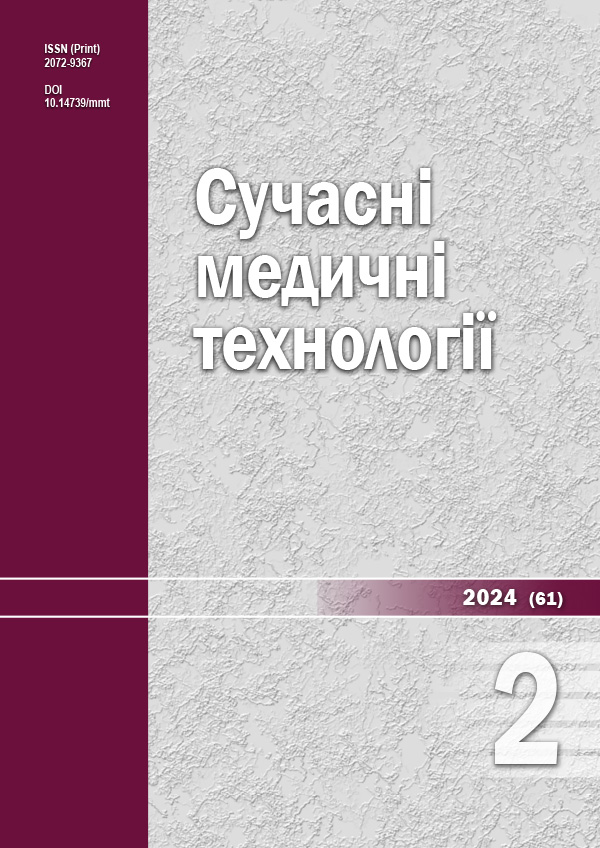The role of adipose tissue cell elements in the regulation of the nitroxidergic system and possible ways of pharmacological modulation
DOI:
https://doi.org/10.14739/mmt.2024.2.299862Keywords:
vasoconstriction, pulmonary artery, type 2 diabetes mellitus, nitrosative stress, eNOS, iNOS, thiotriazoline, angioline, combination of thiotriazoline and L-arginine (1:4), endothelial protectionAbstract
Endothelial dysfunction is characterized by a decrease in the bioavailability of the vasodilator – nitric oxide (NO), and an increase in the level of vasoconstrictor substances. This imbalance leads to vasoconstriction, leukocyte attachment and inflammatory reactions in the vascular wall, atherosclerosis and thrombosis.
The aim: to evaluate the role of adipose tissue elements in the regulation of parameters of the nitroxidergic system under hypoxia conditions.
Materials and methods. The studies were carried out on 30 adult white male Wistar rats. All animals were randomly assigned and divided into groups: a control group (15 rats), type 2 diabetes mellitus (T2DM) was induced in the animals of the second group (15 rats). Isolated fragments of the popliteal arteries (PA) and intrapulmonary artery (IPA) were cleared of perivascular adipose tissue (PVAT-) or left uncleaned (PVAT+) and cut into rings. The simulation of acute hypoxia with further study of medical agents were performed.
Results. The PA and IPA with PVAT responded to acute hypoxia with vasoconstriction – an increase in the amplitude of contraction in the first and second phases, and after removing PVAT, they responded with a decrease in the maximum amplitude of contraction by 3.4 times in the 1st phase and an increase in amplitude by 1.8 times in the 2nd phase. Perfusion with Angiolin reduced 2nd phase of HV of the PA and IPA. Adding a combination of Thiotriazoline and L-arginine (1:4) to a solution for perfusion of fragments of arteries of animals with T2DM, causes a significant increase in constrictor reactions in both the 1st and 2nd phases of HV, regardless of presence of perivascular adipose tissue.
Conclusions. The presence of PVAT affects the HV of arteries, both in normal and in T2DM. The possibilities of ways of pharmacological modulation of the nitroxidergic system depending on the state of PVAT were determined.
References
Silva Andrade B, Siqueira S, de Assis Soares WR, de Souza Rangel F, Santos NO, Dos Santos Freitas A, et al. Long-COVID and Post-COVID Health Complications: An Up-to-Date Review on Clinical Conditions and Their Possible Molecular Mechanisms. Viruses. 2021;13(4):700. doi: https://doi.org/10.3390/v13040700
Yadav S, Bonnes SL, Gilman EA, Mueller MR, Collins NM, Hurt RT, et al. Inflammatory Arthritis After COVID-19: A Case Series. Am J Case Rep. 2023;24:e939870. doi: https://doi.org/10.12659/AJCR.939870
Chary MA, Barbuto AF, Izadmehr S, Hayes BD, Burns MM. COVID-19: Therapeutics and Their Toxicities. Journal of Medical Toxicology. 2020;16:284-94. doi: https://doi.org/10.1007/s13181-020-00777-5
Varga Z, Flammer AJ, Steiger P, Haberecker M, Andermatt R, Zinkernagel AS, et al. Endothelial cell infection and endotheliitis in COVID-19. Lancet. 2020;395(10234):1417-8. doi: https://doi.org/10.1016/S0140-6736(20)30937-5
Guan SP, Seet RCS, Kennedy BK. Does eNOS derived nitric oxide protect the young from severe COVID-19 complications? Ageing Res Rev. 2020;64:101201. doi: https://doi.org/10.1016/j.arr.2020.101201
Costa-Beber LC, Hirsch GE, Heck TG, Ludwig MS. Chaperone duality: the role of extracellular and intracellular HSP70 as a biomarker of endothelial dysfunction in the development of atherosclerosis. Arch Physiol Biochem. 2022;128(4):1016-23. doi: https://doi.org/10.1080/13813455.2020.1745850
Baltieri N, Guizoni DM, Victorio JA, Davel AP. Protective Role of Perivascular Adipose Tissue in Endothelial Dysfunction and Insulin-Induced Vasodilatation of Hypercholesterolemic LDL Receptor-Deficient Mice. Front Physiol. 2018;9:229. doi: https://doi.org/10.3389/fphys.2018.00229
Belenichev I, Aliyeva O, Popazova O, Bukhtiyarova N. Molecular and biochemical mechanisms of diabetic encephalopathy. Acta Biochim Pol. 2023;70(4):751-60. doi: https://doi.org/10.18388/abp.2020_6953
Ganbaatar B, Fukuda D, Shinohara M, Yagi S, Kusunose K, Yamada H, et al. Empagliflozin ameliorates endothelial dysfunction and suppresses atherogenesis in diabetic apolipoprotein E-deficient mice. Eur J Pharmacol. 2020;875:173040. doi: https://doi.org/10.1016/j.ejphar.2020.173040
Li C, Li S, Zhang F, Wu M, Liang H, Song J, et al. Endothelial microparticles-mediated transfer of microRNA-19b promotes atherosclerosis via activating perivascular adipose tissue inflammation in apoE-/- mice. Biochem Biophys Res Commun. 2018;495(2):1922-9. doi: https://doi.org/10.1016/j.bbrc.2017.11.195
Daiber A, Xia N, Steven S, Oelze M, Hanf A, Kröller-Schön S, et al. New Therapeutic Implications of Endothelial Nitric Oxide Synthase (eNOS) Function/Dysfunction in Cardiovascular Disease. Int J Mol Sci. 2019;20(1):187. doi: https://doi.org/10.3390/ijms20010187
Cyr AR, Huckaby LV, Shiva SS, Zuckerbraun BS. Nitric Oxide and Endothelial Dysfunction. Crit Care Clin. 2020;36(2):307-21. doi: https://doi.org/10.1016/j.ccc.2019.12.009
Mcpherson RA, Pincus MR. Henry’s Clinical Diagnosis and Management by Laboratory Methods. 24th ed. St. Louis, Missouri: Elsevier; 2024.
Kolesnik YM. [Report on preclinical study of specific biological activity (anti-ischemic, endothelioprotective) of the drug Lisinium (Angiolin) at parenteral administration]. Zaporozhye, Ukraine; 2018. Ukrainian.
Stefanov OV, editor. Doklinichni doslidzhennia likarskykh zasobiv [Preclinical studies of drugs]. Kyiv: Avitsena; 2001. Ukrainian.
Turrens J. On 'Ubisemiquinone is the electron donor for superoxide formation by complex III of heart mitochondria' by Julio F. Turrens, Adolfo Alexandre and Albert L. Lehninger. Arch Biochem Biophys. 2022;726:109298. doi: https://doi.org/10.1016/j.abb.2022.109298
Delong C, Sharma S. Physiology, Peripheral Vascular Resistance. 2023 May 1. In: StatPearls [Internet]. Treasure Island (FL): StatPearls Publishing; 2024 Jan–. Available from: https://www.ncbi.nlm.nih.gov/books/NBK538308/
Jain PP, Hosokawa S, Xiong M, Babicheva A, Zhao T, Rodriguez M, et al. Revisiting the mechanism of hypoxic pulmonary vasoconstriction using isolated perfused/ventilated mouse lung. Pulm Circ. 2020;10(4):2045894020956592. doi: https://doi.org/10.1177/2045894020956592
Gao F, Chen J, Zhu H. A potential strategy for treating atherosclerosis: improving endothelial function via AMP-activated protein kinase. Sci China Life Sci. 2018;61(9):1024-9. doi: https://doi.org/10.1007/s11427-017-9285-1
Downloads
Published
How to Cite
Issue
Section
License
The work is provided under the terms of the Public Offer and of Creative Commons Attribution-NonCommercial 4.0 International (CC BY-NC 4.0). This license allows an unlimited number of persons to reproduce and share the Licensed Material in all media and formats. Any use of the Licensed Material shall contain an identification of its Creator(s) and must be for non-commercial purposes only.














